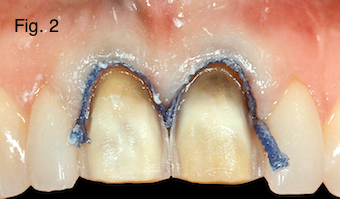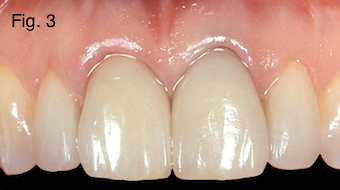Restoring Discolored Endodontically Treated Teeth: Case 2
By Frank Spear on August 20, 2018 |In the previous article in this series I showed the non-vital bleaching of a discolored lateral incisor. In this article I’ll discuss discolored endodontically treated teeth that have existing indirect restorations.
Case 2: Discolored endodontically treated central incisors with existing veneers
This patient presented to me unhappy with the esthetic outcome of the veneers on her central incisors. She disliked the greyness she perceived in the cervical half of each central, as well as the visible margins. The problem was compounded by the fact that they were only six months old. (Figure 1)
The second photo is from the appointment when I removed the veneers, cleaned up the prep and lowered the finish line below tissue .5 - .7 mm. There is significant discoloration on both teeth, but it is limited to the cervical few millimeters. (Figure 2)


I debated whether to prep deeper into the discolored areas and use opacious dentin composite to mask the discoloration, followed by prepping again to ideal, but chose instead to photograph the preps and send the photos to the technician so they could mask the discoloration with the ceramic. I can tell you it was not a good decision. It is very difficult for the technician to mask the dark cervical areas without making opaque looking restorations. Additionally there is the chance that the technician won’t make the veneers opaque enough, and the underlying discoloration will show through, which is what happened in this case. (Figure 3)
I tried multiple brands of opaque try-in pastes to see if I could use the first set of veneers but none of them produced an acceptable result. In my experience the final cement may not produce the same result the try-in paste did. Ultimately I had these veneers remade by the lab three times before they were acceptable. (Figure 4) This could have been avoided had I simply used composite to mask the dark areas before the final prep and impression.


I get the question all the time if crowns would have been a better choice in a case like this rather than veneers. Certainly a crown with an opaque core could have masked the discoloration easily. However, when the teeth are intact except for the composite in the access cavity and the discoloration is localized, I always prefer to mask the discolored area and maintain more natural tooth structure with a veneer.
(If you enjoyed this article, click here for more by Dr. Frank Spear.)
The Practice of Excellence for Surgical Specialists
Learn how to maximize practice growth without just "doing more." Join us from October 5-7 for a hands-on practice growth workshop that will jumpstart your best practice.
LEARN MORE